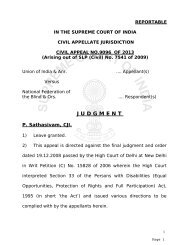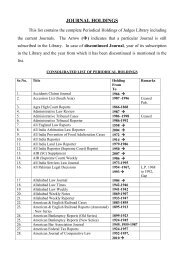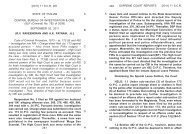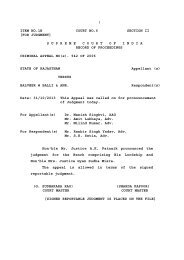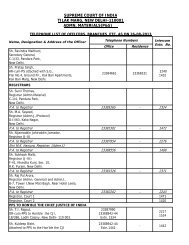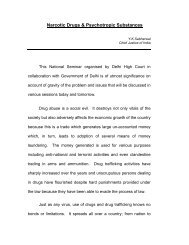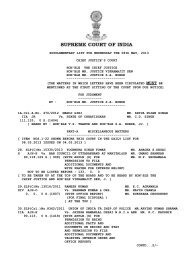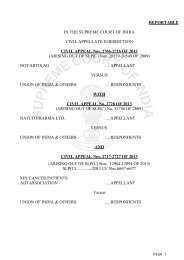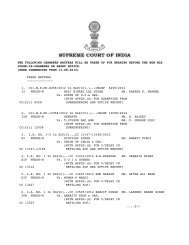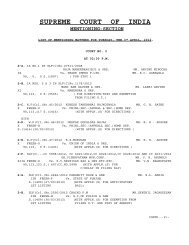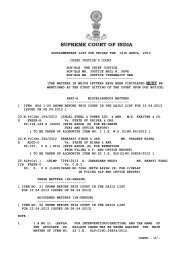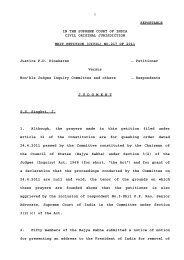Part No.IV - Supreme Court of India
Part No.IV - Supreme Court of India
Part No.IV - Supreme Court of India
Create successful ePaper yourself
Turn your PDF publications into a flip-book with our unique Google optimized e-Paper software.
MAHADEV GOVIND GHARGE v. SPL. LAO UPPER KRISHNA<br />
PROJECT JAMKHANDI, KARNATAKA<br />
fixes the period <strong>of</strong> limitation to be computed from the date<br />
<strong>of</strong> service <strong>of</strong> notice <strong>of</strong> hearing <strong>of</strong> the appeal upon the<br />
respondent/cross-objector and within one month <strong>of</strong> such<br />
date he has to file cross objections. Thus, the crucial<br />
point <strong>of</strong> time is the date on which the notice <strong>of</strong> hearing<br />
<strong>of</strong> the appeal is served. This could be a notice for actual<br />
date <strong>of</strong> hearing or otherwise. [Para 42] [863-A-B]<br />
5.3. There appears to be a dual purpose emerging<br />
from the language <strong>of</strong> Order XLI Rule 22 <strong>of</strong> the Code.<br />
Firstly, to grant time <strong>of</strong> one month or even such further<br />
time as the Appellate <strong>Court</strong> may see fit to allow; and<br />
secondly, to put the party or his pleader at notice that the<br />
appeal has been admitted and is fixed for hearing and the<br />
<strong>Court</strong> is going to pronounce upon the rights and<br />
contention <strong>of</strong> the parties on the merits <strong>of</strong> the appeal.<br />
Once such notice is served, the period <strong>of</strong> limitation under<br />
Order XLI Rule 22 <strong>of</strong> the Code will obviously start running<br />
from that date. If both these purposes are achieved any<br />
time prior to the service <strong>of</strong> a fresh notice then it would<br />
be an exercise in futility to issue a separate notice which<br />
is bound to result in inordinate delay in disposal <strong>of</strong><br />
appeals which, in turn, would be prejudicial to the<br />
appellants. A law <strong>of</strong> procedure should always be<br />
construed to eliminate both these possibilities. [Para 43]<br />
[863-C-E]<br />
6.1. In the present case, the appellant appeared and<br />
argued at the admission stage <strong>of</strong> the appeal which was<br />
admitted in their presence and an order was also passed<br />
for final hearing. The appellants had also filed caveat in<br />
the appeal. In law, the rights <strong>of</strong> a caveator are different<br />
from that <strong>of</strong> cross-objectors per se. In terms <strong>of</strong> Section<br />
148A <strong>of</strong> the Code, a caveator has a right to be heard<br />
mandatorily for the purposes <strong>of</strong> passing <strong>of</strong> an<br />
interlocutory order. The law contemplates that a caveator<br />
is to be heard by the court before any interim order can<br />
839 840<br />
A<br />
B<br />
C<br />
D<br />
E<br />
F<br />
G<br />
H<br />
A<br />
B<br />
C<br />
D<br />
E<br />
F<br />
G<br />
H<br />
SUPREME COURT REPORTS [2011] 8 S.C.R.<br />
be passed against him. But in the present case when the<br />
appeal was listed for hearing at the admission stage<br />
itself, the appellants had appeared and argued the matter<br />
not only in relation to grant <strong>of</strong> an interim order but also<br />
on the merits <strong>of</strong> the appeal. As evident from order dated<br />
12-9-2001 <strong>of</strong> the High <strong>Court</strong>, the records were required<br />
to be called for from the lower courts and thereafter, the<br />
appeal was to be heard finally. Though the court had not<br />
actually fixed any particular date, it had directed the<br />
appeal to be listed for hearing. Then again, vide a<br />
subsequent order, the High <strong>Court</strong> had directed the<br />
appellant(s) to move an application for early hearing <strong>of</strong><br />
the appeal. On all these occasions, the appellant(s), or his<br />
pleader, was present and participated in the proceedings<br />
before the <strong>Court</strong>. Thus, the appellant(s) not only had the<br />
knowledge <strong>of</strong> pendency <strong>of</strong> the appeal but also had notice<br />
<strong>of</strong> fixing <strong>of</strong> hearing <strong>of</strong> the appeal. Even on a further<br />
subsequent date, the High <strong>Court</strong> took notice <strong>of</strong> the crossobjection<br />
and counsel for the appellant(s)/cross objector<br />
was directed to furnish copies <strong>of</strong> the cross-objection<br />
within three weeks to the Additional Advocate General.<br />
After the records from lower courts were received, the<br />
matter was heard and judgment impugned in the present<br />
appeal was pronounced by the High <strong>Court</strong> in the year<br />
2003. [Paras 45, 46 and 47] [865-B-H; 866-A-E]<br />
6.2. In the circumstances, it is difficult for this <strong>Court</strong><br />
to hold that the period <strong>of</strong> 30 days, as contemplated under<br />
Order XLI Rule 22 <strong>of</strong> the Code, never commenced even<br />
till final disposal <strong>of</strong> the appeal. Such an interpretation will<br />
frustrate the very purpose <strong>of</strong> the Code and would be<br />
contrary to the legislative intent. The appeal was finally<br />
heard without fixing any particular date and in presence<br />
<strong>of</strong> the appellant(s). Under such circumstances, the<br />
requirement <strong>of</strong> fixing a final date separately must be<br />
deemed to be waived by the parties. [Para 48] [866-F-G]



